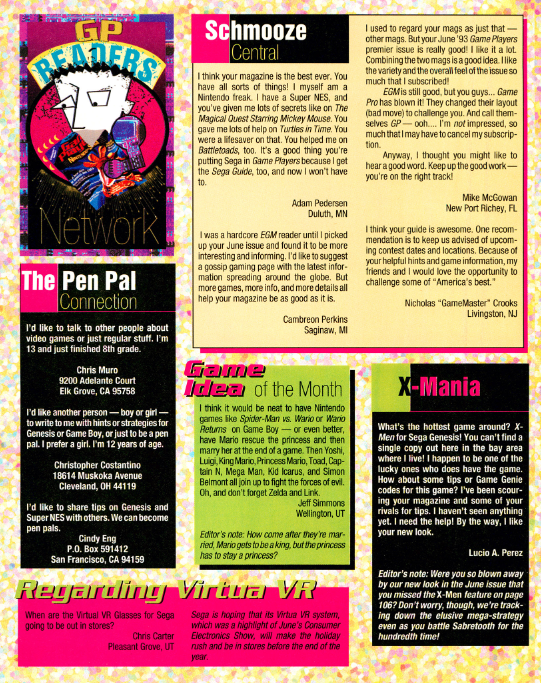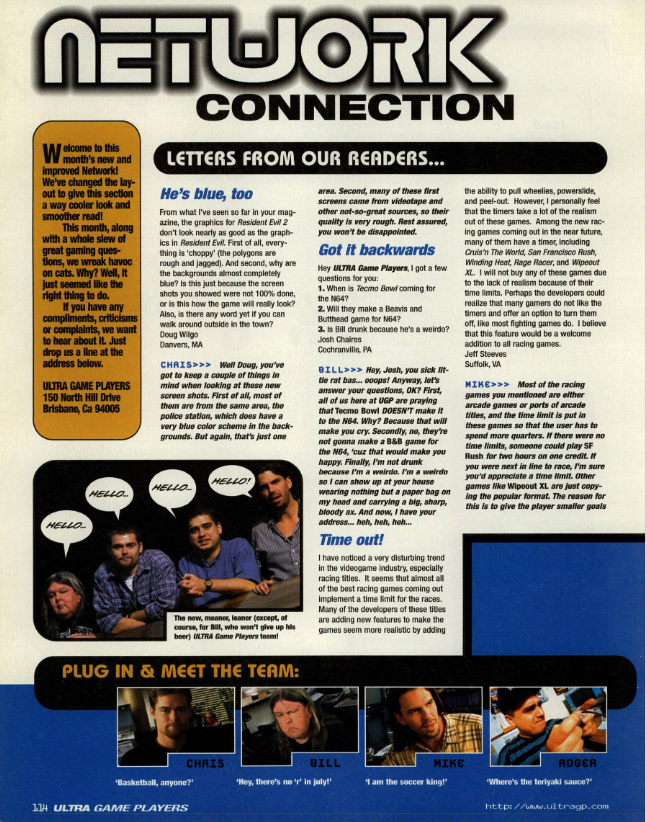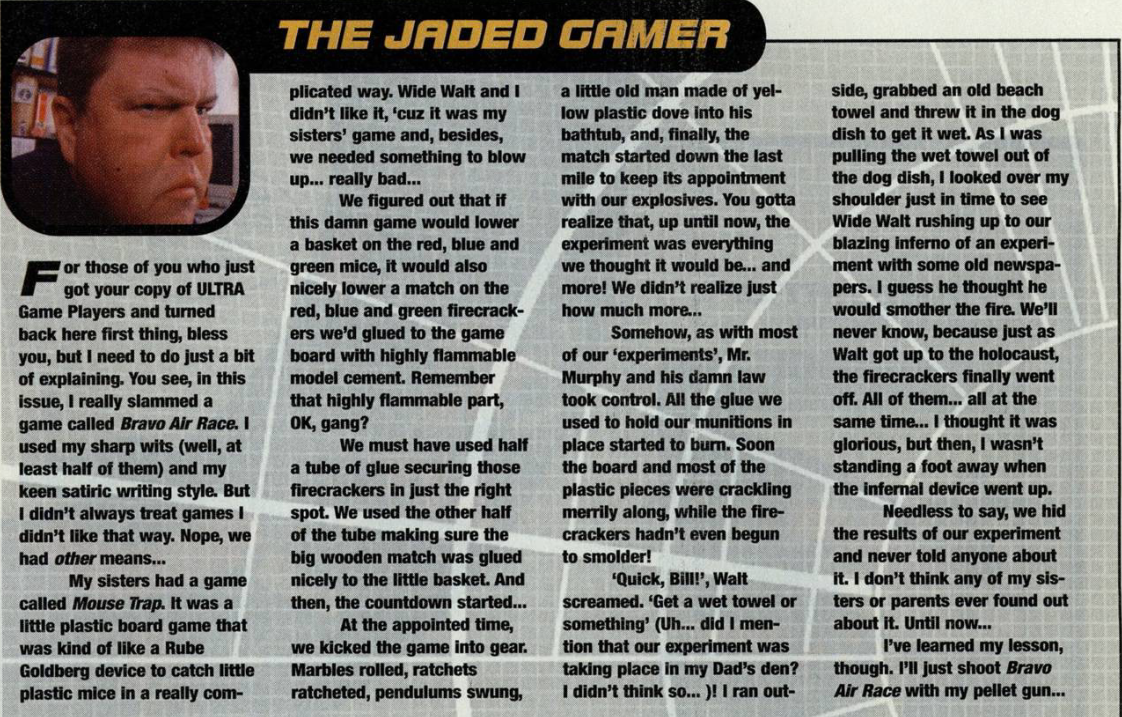Release My Faithful From the Asylums: The History of Game Players Magazine
Celebrating the golden age of video game magazines

Back in the retro age, a subscription to a video game magazine was about as essential to the gaming experience as the console and controllers. With no high-quality websites and very little television presence, the only way to get the dirt on what was coming up was to either shell out for that subscription or pay the issue-to-issue bonus at the newsstand – or, if that was still too much, try to find a subscribing friend who wouldn't give you too much grief.
Not that this was ever a problem for me. Over the years, I managed to accrue a decent collection of video game magazines – most from subscriptions, but many from one-off purchases at rest stop convenience stores and airport bookstores. I had enough that, for a while, my bedroom featured a bookshelf dedicated to magazine holders.
Of course, most people (let alone most children) wouldn't bother keeping an archive of magazines that are, essentially, buyer's guides. But that shelf wasn't a mere display piece. Well into high school, there was one particular periodical that I would pull out from time to time to revisit in its entirety. This was Game Players magazine, the first for which I ever held a subscription.
While Game Players was far from the biggest of its kind, you may have heard of it. It is a publication held in very high esteem by those who purchased or subscribed to it. And why is that? Why would I keep rereading old issues years after the information inside was obsolete?
The basic, boring history of Game Players magazine starts in 1989 with the launch of what was then known as Game Player's Strategy to Nintendo Games, an unofficial corollary to Nintendo Power that had launched a year earlier. As with Nintendo Power, this version of the magazine was targeted at a young demographic and featured a heavy emphasis on guides and walkthroughs, which often comprised a majority of the content pages.
Game Player's Strategy to Nintendo Games proved popular enough to get a sister publication for Sega games, known as Game Player's Sega Genesis Guide. The Sega magazine was never as popular as the Nintendo original, and soon the two were combined into a single publication known as Game Players Nintendo * Sega and, eventually, just Game Players – this version of the magazine being more of a consumer guide than a strategy publication. It kept this name until 1996 when it was rebranded as Ultra Game Players, and was ultimately discontinued in 1998 after 111 issues.
By the numbers, it's not immediately obvious why so many people have a fondness for Game Players. It was one of many video game magazines launched as the industry emerged from the crash, it had a typical layout for its time and didn't have a particularly long run (by contrast, GamePro launched the same year and lasted until 2011). Brevity aside, Game Players did bring a few things to the table. It was one of the first video game magazines to have a significant online presence, a forward-thinking move at a time when most publishers viewed the internet with either derision or fear.
From a reader's perspective, though, the most memorable aspect of Game Players lies in the Readers' Network.

The mailbag was always a de rigeur section in most publications, something that existed because it had to. It was a one- or two-page spread tucked away somewhere in the back where most people could comfortably ignore it.
Game Players was different. The mail section, known as the GP Readers' Network, was added in 1993 and was thereafter treated as an important part of the magazine. While the Reader's Network changed over the years, every iteration had a few things in common. It was always relatively long, spanning three to six pages. It was often placed close to the front, whereas most magazines chose to make the letter section one of the last things in the layout.
The Readers' Network was more than a mailbag section, though – it was intended as a hub of sorts for the subscriber base, containing several special recurring features. Among the more durable features were the Burning Question, a monthly open question for discussion; Game Idea of the Month, exactly what it says on the tin; Pen Pal Connection, an open forum for people seeking long-distance friends (and occasionally from developers seeking feedback, as when Cliff Bleszinski wrote into the August 1994 issue); and Pushing the Envelope, a reader art section.
The intention behind these features was to encourage people to write in, and it worked. The Readers' Network became a center for discussions and arguments that could span several issues.
Then, after a few years, things got interesting.

From the moment that one opened the March 1995 issue of Game Players and saw Slippy Toad alongside the other editors in the Meet the Team section, it was obvious that things were going to be different.
This was the first issue published under the watchful eye of Chris Slate. Slate had been involved with Game Players since very early in its existence, and the departure of Editor in Chief Mark Higham opened up room at the top. Changes were immediate if not immediately obvious. The format and style remained largely the same, but there was a very different feel to the writing. Game Players under Chris Slate would become known primarily for its surreal sense of humor.
The Meet the Team section that opened each issue was a good example of this. The last slot on editor's row turned into a rotating cast of bizarre in-jokes that built on the magazine's internal mythology. These “editors” included a shapeshifter called “Gamer X” who would disguise himself as a page of the magazine; Dead Horse, who – being a dead horse – could only respond to questions with “......”; and Gazuga, a pagan deity in the form of a 900-foot tall, three-eyed gorilla.

Gazuga demonstrated another aspect of the humor: It was a two-way street. His appearance marked the start of a three-issue event dubbed “the Cleansing,” an apocalyptic event in which readers were encouraged to write in as either servants of Gazuga or as rival figures in the ever-growing Game Players cosmology. This was not merely a one-off event, either, as it would be referenced for years to come, including in hidden messages seeded throughout the magazine – another Game Players signature.
The lean into humor was a risky move, and not everyone appreciated it, but it probably paid off for Game Players in the long run. This unique aspect of the magazine gave it a puncher's chance against bigger publications such as EGM and GamePro and is likely the reason that it endured as long as it did.
In October 1996, Game Players debuted a major rebrand and redesign, becoming Ultra Game Players. UGP would maintain continuity in its issue numbers from the Game Players years (the first UGP is technically GP #89), but other than this just about everything had been changed. The new name is an obvious reference to the Nintendo 64 (formerly known as the Ultra 64) which had launched in North America the month before, and the stated purpose was to update the magazine as the industry headed into the fifth generation.
Content-wise, UGP had a few new wrinkles. It included PC game reviews for the first time, along with hardware reviews for both PC and consoles. It introduced the Gameshop, a monthly trivia contest that offered a range of prizes – ranging from games and consoles to full-size coin-ops and even a Yaroze in the Gameshop's final appearance in issue #99.
The most obvious change was in the visual design. Earlier versions of Game Players featured a colorful design meant to appeal more to children and pre-teens, who were understood to be the primary consumers of video games. But as the age of both the video game market in general and the audience for Game Players increased, the editors opted for a cleaner, more stylized design meant with adults in mind.

But forget all that – what about the Readers' Network? It was still there, but it had changed. Many of the older features had been removed and replaced. The new Network features included Ask the Industry, in which representatives from game companies fielded questions from readers, and Fan Site of the Month, which promoted the internet projects of their readers.
All of this was interesting, but some people complained that UGP was backing away from the surreal humor of its earlier incarnation. The Network just didn't feature those bizarre letters that one could have seen in the past year and a half. I don't fully agree, though. True, the letters weren't as weird, but on the other hand, the new Network also included the best feature to ever appear in a Game Players publication: The Jaded Gamer.
And to explain why that's so great, I need to talk about another long-time editor.
Let's get this out of the way for anyone who might stumble in here late in the game: the Bill Donohue who worked for Game Players (among other publications) has no connection to the infamous head of the Catholic League who happens to have the same name. Just so we're clear.
Donohue joined the Game Players staff in September 1994 as a production editor. From his first issue, he was part of the public face of the magazine. He managed the Pushing the Envelope art section of the Readers' Network, adding snarky little captions to the submissions. This was one of the first uses of humor in the magazine, even before Slate's tenure as Editor in Chief.
As Game Players shifted its emphasis over to the humor, Donohue became the face of that humor, with a manic, hard-drinking persona that tied into every aspect of the Game Players mythos. He was, at various times, the caretaker of “the box,” a hazing device for new editors that occasionally disgorged an extradimensional being; the leader of an army of Undead and Possibly Brain-Damaged Lizard warriors; and the largely useless superhero “Super Buddy,” whose only real power seemed to be becoming overly chummy after a few beers.

With the launch of Ultra Game Players, Donohue received a column of his own. Titled “The Jaded Gamer,” this was a half-page column in which Donohue – in the character of the titular Jaded Gamer, a disturbed individual writing from the Brisbane Home for the Twisted and Bitter – would rant at length about why every new video game was bad. It typically got weird from there, as in the very first column where, near the end, he argued that he had proof that Mario was connected to (or possibly in charge of) a criminal organization.
Jaded Gamer columns fall into a few buckets. Some are recommendations for how games could be improved, always including some overly dramatic illustration – as when JG argued that anyone who thought it was acceptable to play a racing game with a behind-the-car camera should be strapped into an elaborate device suspended behind an actual car and forced to drive that way. Other times, the game in question was a segue into a twisted childhood story, a surprising number of which involved an unsafe vehicle barreling down a hill at treacherous speed. They were all strange beasts, and have aged better than some of the other content – remaining funny even if one doesn't recall the game in question.
I should also mention that Donohue fronted a band called “The Rockin' Chair.” I happen to own some of their CDs. They were...fine.

In June 1997, Chris Slate departed UGP to head up a new project: The Sony-focused magazine PSM. In his place was new arrival Frank O'Connor, today best known for his work at Halo studio 343 Industries.
From the outside, all of this looked fairly dire, especially with cracks appearing in the foundation. The issues became steadily thinner over its final year or so, and the Gameshop – the UGP trivia contest – shed its big-ticket prizes prior to being unceremoniously discontinued in August 1997. As an adult, these changes – along with the shakeup at the top – are red flags. As a child, I really didn't see it coming.
The 111th and final issue of UGP came out in June 1998, but this wasn't exactly the end of Game Players. The following month, subscribers found something new in their mailboxes – Game Buyer, the most direct successor publication.
No one seems to have much to say about Game Buyer. Given that the magazine only ran four issues, this isn't surprising. However, I will argue that Game Buyer #1 might be the single best video game publication I've ever read. It introduced sprawling multi-page spreads for reviews, complete with full-page images – a rarity at a time when screenshots were seldom more than an inch or so across. It also brought back handheld reviews, which had been absent from its predecessor for years.
But that's only the half of it, as Game Buyer also contained an impressive set of monthly features. There was a sizable hardware section which even included reviews of components for people who wanted to build their own PCs. There was the “Slick Stuff” section, covering a range of electronics and pop culture topics – I'll always remember this as the first place I read of the new Star Wars movies. There was “Whatever Happened To,” a brief history of a landmark console. And, being a Game Players descendant, there was the “Padded Cell,” home to a subset of the madness that readers had come to expect.
It's a shame that those features didn't appear in all four issues. They came and went as the editorial staff tested the waters on what people wanted to see. The final issue of Game Buyer was a thin, sad shell that featured almost none of the above. It was a minor mercy when an issue of Next Generation showed up the following month.

And yet Game Players managed to live on for a few more years, at least in spirit. PSM, Chris Slate's publication, may have been the true successor magazine. Not only did a lot of the Game Players staff end up working at PSM after the death of Game Buyer, but the magazine itself had a familiar feel with a lot of familiar features. It had a Game Players-like Meet the Team section and their mailbag borrowed many concepts from the old Readers' Network, including reader-submitted game ideas, a monthly question for discussion, and a networking section.
It didn't stop there. Game Players-style humor cropped up in various and disparate magazines for a while after its death, perhaps carried by the former staff. It even showed up in the rather stodgy Nintendo Power – a publication that, perhaps not coincidentally, Chris Slate ran for a while. There were plenty of people in the industry who thought that leaning into humor might work out for them as well.
Next Generation, the Game Players sister publication, was not one of these. In fact, this magazine proved to be a very different beast – but that's a topic for next time.
Interested in reading some vintage issues? Retro CDN has full scans of many issues of both Game Players and Ultra Game Players.
